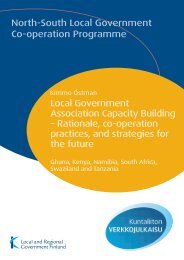E-READINESS QUESTIONNAIRE FOR NORTH ... - Kunnat.net
E-READINESS QUESTIONNAIRE FOR NORTH ... - Kunnat.net
E-READINESS QUESTIONNAIRE FOR NORTH ... - Kunnat.net
Create successful ePaper yourself
Turn your PDF publications into a flip-book with our unique Google optimized e-Paper software.
46<br />
Act, which set up the Communications Commission of Kenya (CCK) an independent<br />
industry regulator with the mission to improve the livelihoods of Kenyans by ensuring<br />
the availability of accessible, effi cient, reliable and affordable ICT services.<br />
Kenya’s telecommunications and broadband market is undergoing a revolution following<br />
the arrival of three fi bre optic international submarine cables in Kenya in 2009<br />
and 2010 (Seacom, TEAMS and EASSy), ending its dependency on limited and expensive<br />
satellite bandwidth. Bandwidth prices had already fallen signifi cantly following<br />
the liberalisation of international gateway and national backbone <strong>net</strong>work provision<br />
in 2005, but they have now fallen by 90%, enabling cheaper tariffs for telephone calls<br />
and broadband Inter<strong>net</strong> services. However, Inter<strong>net</strong> service providers (ISPs) have only<br />
reluctantly passed on the cost savings to end customers, which has prompted the industry<br />
regulator to consider price caps.<br />
Besides tariff regulation, other regulatory issues on the agenda in 2010 include interconnection,<br />
number portability and universal service.<br />
A simplifi ed and converged licensing regime introduced in 2008 has lowered the<br />
barriers to market entry and increased competition by allowing operators to offer any<br />
kind of service in a technology – and service-neutral regulatory framework.<br />
Several fi bre infrastructure sharing agreements have been forged. At least six major<br />
deployments of WiMAX technology are underway and 3G mobile broadband services<br />
with up to 7.2Mb/s have been launched. Advanced services such as IPTV/triple-play,<br />
e-commerce, e-learning and e-government are now rapidly evolving.<br />
The country’s incumbent fi xed-line telephone company, Telkom Kenya, is revamping<br />
its infrastructure and services under the Orange brand with fresh capital from its<br />
new majority shareholder, France Telecom. It has also re-entered the mobile market<br />
and has embarked on a strategy to transform itself into a true broadband connectivity<br />
provider.<br />
The Inter<strong>net</strong> fi rst became available in Kenya to in 1993. Full Inter<strong>net</strong> access was<br />
established in 1995. Since many people do not have fi xed phone lines, computers, or<br />
electricity, inter<strong>net</strong> shops, known as cyber cafes, provide access to inter<strong>net</strong> and email.<br />
This is mainly in the major towns. Kenya has 10 fi xed phone lines per 1000 people.<br />
For mobile phones, the number is 50 phones per 1000 people. In Africa, about 100<br />
million out of the total 906 million people now use cell phones. Many users in the urban<br />
areas run their own small businesses. In the rural areas, cell phones are mostly used<br />
in social circles.<br />
A major factor that may have infl uenced the use of ICT both positively and negatively<br />
is the use of the English language. English is the offi cial language in Kenya.<br />
Information technology services are largely based in English, so this is an advantage.<br />
However, there are at least forty tribal languages in the country, and this sometimes<br />
presents problem in content creation.<br />
5.5 Kenya Telecommunications Profi le 2010<br />
Telephones - main lines in use<br />
243,700 (2008)<br />
Telephones - mobile cellular<br />
16.304 million (2008)<br />
Telephone system<br />
General assessment: inadequate; fi xed-line telephone system is small and ineffi cient;<br />
trunks are primarily microwave radio relay; business data commonly transferred by a<br />
very small aperture terminal (VSAT) system<br />
Domestic: no recent growth in fi xed-line infrastructure and the sole provider, Telkom




